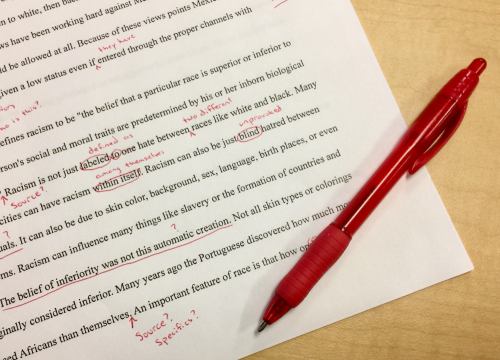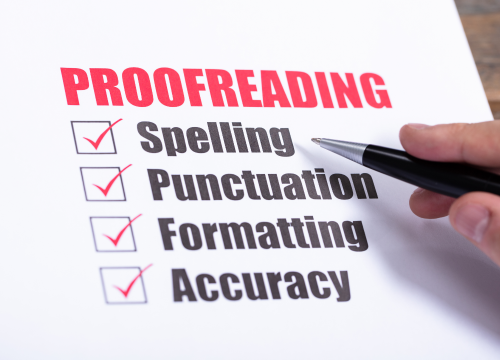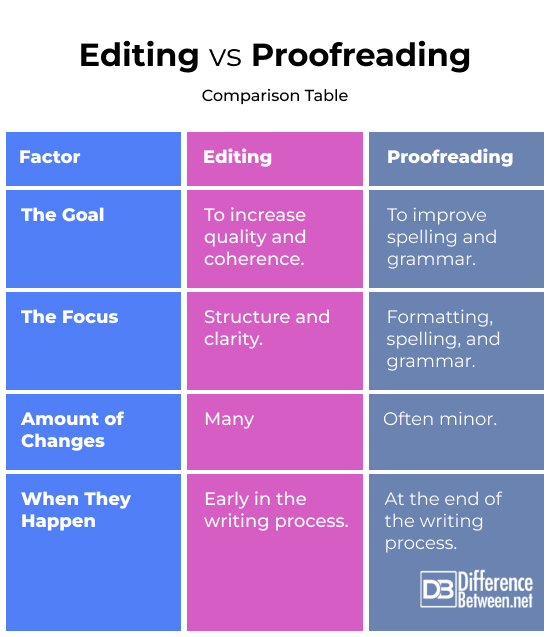Difference Between Editing and Proofreading
Editing and proofreading are closely related to each other. They both involve checking a piece of writing to ensure that it meets certain quality standards. However, editing and proofreading aren’t quite the same things, and today we’re here to discuss what those differences are.

What is Editing?
Editing is about reviewing text and changing it to improve the readability and overall quality of it. Content could be changed substantially, including wording, tone, and even factual information.

What is Proofreading?
Proofreading involves simply scanning over a text to make sure that spelling, punctuation, and grammar are correct.
Similarities Between Editing and Proofreading
There are a few notable similarities between editing and proofreading worth noting.
- Both are designed to make a text better
- Both are required as a part of the writing process
- Both require the person performing the task to be detail oriented
Differences Between Editing and Proofreading
There are some notable differences between editing and proofreading too.
- Editing is about style, content, and structure. Proofreading is about grammar and spelling.
- Editing is characterized by largescale changes, whereas proofreading makes smaller changes.
- Editing happens before proofreading.
Editing vs Proofreading: Comparison table

FAQs
Can an editor be a proofreader?
An editor can take on the role of a proofreader as well. The roles, while distinct, share a common goal: to improve sentence structures, correct word usage and sentence punctuation. The editor, who dives into the structure, clarity, and flow of text, can easily switch to the proofreading level, which is full of finer details.
However, the former method is more of a judicious process that involves the careful scrutiny of grammar, punctuation, and spelling errors. It is a smooth flow from the macro to the micro level that guarantees everything is interesting and well-connected while being error free.
In addition to the ability to edit, this skill set also offers the possibility to proofread, which will be a result of the combined effort of the two tasks. Thus, this will lead to comprehensive approach of revising the written work ensuring that it is not only rich in substance but also in form.
What is the difference between revision and editing proofreading?
Proofreading and revision differ in the sense that they normally occur at different stages during the writing process, each having its own emphasis.
Revising is the transitional stage which requires that the writer critically assesses the structure of the content, the strength of the argument and the overall cohesiveness.
In a way, it’s also about the micro-level things – making changes that will enhance the coherence and strengthen the narrative flow to better make the message obvious. But, different from proofreading, editing is the final gloss, a really thorough check for grammatical mistakes, typos, and discrepancies in formatting.
It guarantees the text is ready for the audience as well, without any distractions that could be a deterrent to the text’s effectiveness. Although revision determines the form of the material, proofreading makes sure that this form is impeccable.
What is the difference between proofreading and line editing?
Proofreading and line editing are the two most important steps in the writing process, whose functions, however, are quite different.
Line editing concentrates on the elements of writing, dealing with the structure of the sentences, language, and style, in a way which makes the text more readable and engaging. It is about polishing the voice, improving the flow, and checking the for the clarity sake, that the reader can listen to the text.
Proofreading differs from editing in that it is the ultimate quality control, the fine toothed comb that looks for typos, grammatical errors, and punctuation issues.
It is the last stage that precedes publication, cleansing it from any imperfections that may ruin the document’s professionalism. Two components of the process are line editing which makes the content better and proofreading which ensures accuracy.
What is the difference between proofreading symbols and editing symbols?
Proofreading symbols and editing symbols are of a refining nature; each set of symbols is used for a specific purpose. Proofreading symbols, are short-hand for indicating and fixing superficial problems such as misspellings, wrong punctuations and formatting errors.
They are used to input new information or to make some minor changes in the text in order to eliminate possible mistakes.
Editing symbols, on the other hand, help to affect a higher level of changes such as structure, organization, and clarity of the piece of work.
They highlight paragraphs and sentences that might be reordered, removed, or added to the text to improve readability. Whereas proofreading symbols guide to the rightness, editing symbols are directed to improvement of effectiveness and readability.
What comes first proofreading or editing?
Among the stages of work on a manuscript, editing is always the stage before proofreading. Editing is the first major review step that involves the detailed attention to content structure, clarity and style.
It deals with the text’s approach, the argument in the text, and the voice used, making changes where required to make sure the message is clear and convincing.
Now that all of these more complex ones have been resolved, proofreading is the last thing to do.
This step is intended to get rid of surface defects; wrong spelling, grammar mistakes and punctuation errors are examples of those defects. The mentioned process is the comprehensive refinement of the manuscript, including both its content and form, is done to edit the manuscript before publishing.
What is the difference between editing and proofreading in academic writing?
Regarding academic writing, editing and proofreading have two different, but equally important roles. In this area of editing, there is an analytical and critical assessment of the argument’s integrity, comprehensibility of expression, and the arrangement of thought.
It basically deals with improving the organization, logically persuasion, and the scholarly merit of the text, ensuring it passes the academic standards of research.
On the contrary, examples of proofreading are fixing grammatical errors, typos, and formatting inconsistencies. It is responsible for the document being cited properly and that it follows academic principles, thus making research work clean, and with no errors in it.
- Difference Between IELTS and TOEFL - May 14, 2024
- Difference Between Tactics And Strategy - May 11, 2024
- Difference Between Zionism and Judaism - March 7, 2024
Read More ESL Articles
Search DifferenceBetween.net :
4 Comments
Trackbacks
- Difference Between Illustrator and InDesign | Difference Between | Illustrator vs InDesign
- Difference Between Resolution and DPI | Difference Between | Resolution vs DPI
Leave a Response
References :
[0]George, E. O. (2022, December 16). Differences between editing and proofreading | Paperpal. Paperpal Blog. https://paperpal.com/blog/academic-writing-guides/language-grammar/differences-between-editing-and-proofreading
[1]What is the difference between proofreading and editing?. Scribbr. (2020, July 1). https://www.scribbr.com/frequently-asked-questions/what-is-the-difference-between-proofreading-and-editing/#:~:text=The%20first%20stages%20of%20editing,it%20is%20published%20or%20shared.
[2]Editing, A. in. (2022, December 15). What are the Main Differences between Academic Proofreading and Editing? | PM Proofreading Services. https://proofreadingmalaysia.com/what-are-the-main-differences-between-academic-proofreading-and-editing/
[3]Image credit: https://www.canva.com/photos/MADQ4-ht6qc/
[4]Image credit: https://www.canva.com/photos/MADnQJNnqsc-proofreading-checklist/

I enjoyed reading your blog, and I agree with everything you say…in fact, I think I have tried all of your suggestions at one time or another. I don’t find that it encourages people one way or the other.
There is an even larger difference between proofreading a document and proofing typeset copy for a book print. The latter you do not read anything! You compare manuscript to copy… character by character, line by line including all spacing and font sizes to make sure it is identical to the manuscript and fits the uniformity of the book specs.